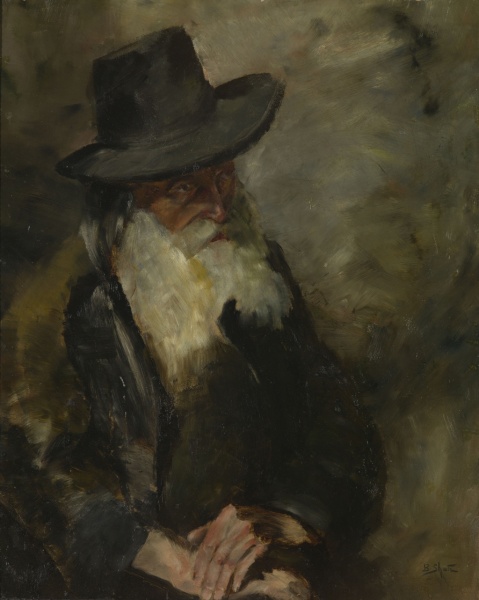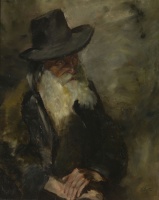
A Jewish Wiseman (recto). Spring Flowers (verso)
| Author: | Boris Schatz (1866/7–1932) |
The parents of Boris (Baruch) Schatz (b. 1866 Varniai – d. 1932 Denver, USA, buried in Jerusalem) sent their 16-year-old son to study at a Vilnius yeshiva in the hope that he would become a rabbi; but instead he enrolled in the Vilnius School of Drawing, where he studied from 1882 to 1887. In Vilnius he became an active Zionist. Leaving for Warsaw in 1888, he settled in Paris the next year. Schatz made his first famous reliefs in Paris, in which he captured prominent figures of the time, including the sculptor Mark Antokolsky. From 1895 he worked as a teacher at the Royal Academy of Art in Sofia, at the invitation of the Bulgarian Prince Ferdinand I. He met the Zionist leader Theodor Herzl in Vienna in 1903, travelled to Palestine, founded the Bezalel School of Arts and Crafts in Jerusalem in 1906, the first art institution in Palestine, and was its headmaster for 16 years. In 1900 he won a gold medal at the Exposition Universelle in Paris, and in 1904 he won a silver medal at the St Louis World’s Fair in the USA.
Source: Ellex Valiunas (LAWIN until 2015) art album: STORIES OF LITVAK ART (2023). Compiler and author Vilma Gradinskaitė.
Sculptor, painter and teacher. Born in 1867 in Varniai, died on 22 March 1932 in Denver (USA), buried in Jerusalem. From 1882 to 1887, he attended the Vilnius Rabbinical School and the Vilnius Drawing School. In 1888, he took sculpture classes in Warsaw, and in 1889, left for Paris and studied privately under Mark Antokolsky, later – in Fernand Cormon’s studio. Between 1895 and 1903, upon the invitation of the Bulgarian prince Ferdinand, he lived in Bulgaria, and was an official court sculptor and the first teacher of sculpture in the Sofia Public Drawing School. In 1905, at a Zionist congress in Basel, Schatz was invited to establish a Jewish art school in Jerusalem. In 1906, he founded the Bezalel School and organized exhibitions of its students’ works in Europe and the USA. Plots of his early sculptures are mainly based on motifs of the Bible and Jewish national revival, and later works are characterized by the stylistics of art nouveau. Beside sculptures, bas-reliefs and portrait medallions, he created lithographs and paintings. Motifs of the Old Testament are predominant in his work. He was awarded the silver and gold medals at the Paris World Fair in 1900, and at the Louisiana exhibition in 1904.
Source: Académie de Vilna: Vilniaus piešimo mokykla 1866-1915 / Vilnius drawing school: Exhibition Catalogue, Nacionalinė dailės galerija 2017 m. 4 d. - lapkričio 26 d., compiled by Jolanta Širkaitė, Vilnius: Lietuvos kultūros tyrimų institutas, 2017, p. 322.

The parents of Boris (Baruch) Schatz (b. 1866 Varniai – d. 1932 Denver, USA, buried in Jerusalem) sent their 16-year-old son to study at a Vilnius yeshiva in the hope that he would become a rabbi; but instead he enrolled in the Vilnius School of Drawing, where he studied from 1882 to 1887. In Vilnius he became an active Zionist. Leaving for Warsaw in 1888, he settled in Paris the next year. Schatz made his first famous reliefs in Paris, in which he captured prominent figures of the time, including the sculptor Mark Antokolsky. From 1895 he worked as a teacher at the Royal Academy of Art in Sofia, at the invitation of the Bulgarian Prince Ferdinand I. He met the Zionist leader Theodor Herzl in Vienna in 1903, travelled to Palestine, founded the Bezalel School of Arts and Crafts in Jerusalem in 1906, the first art institution in Palestine, and was its headmaster for 16 years. In 1900 he won a gold medal at the Exposition Universelle in Paris, and in 1904 he won a silver medal at the St Louis World’s Fair in the USA.
Source: Ellex Valiunas (LAWIN until 2015) art album: STORIES OF LITVAK ART (2023). Compiler and author Vilma Gradinskaitė.
Sculptor, painter and teacher. Born in 1867 in Varniai, died on 22 March 1932 in Denver (USA), buried in Jerusalem. From 1882 to 1887, he attended the Vilnius Rabbinical School and the Vilnius Drawing School. In 1888, he took sculpture classes in Warsaw, and in 1889, left for Paris and studied privately under Mark Antokolsky, later – in Fernand Cormon’s studio. Between 1895 and 1903, upon the invitation of the Bulgarian prince Ferdinand, he lived in Bulgaria, and was an official court sculptor and the first teacher of sculpture in the Sofia Public Drawing School. In 1905, at a Zionist congress in Basel, Schatz was invited to establish a Jewish art school in Jerusalem. In 1906, he founded the Bezalel School and organized exhibitions of its students’ works in Europe and the USA. Plots of his early sculptures are mainly based on motifs of the Bible and Jewish national revival, and later works are characterized by the stylistics of art nouveau. Beside sculptures, bas-reliefs and portrait medallions, he created lithographs and paintings. Motifs of the Old Testament are predominant in his work. He was awarded the silver and gold medals at the Paris World Fair in 1900, and at the Louisiana exhibition in 1904.
Source: Académie de Vilna: Vilniaus piešimo mokykla 1866-1915 / Vilnius drawing school: Exhibition Catalogue, Nacionalinė dailės galerija 2017 m. 4 d. - lapkričio 26 d., compiled by Jolanta Širkaitė, Vilnius: Lietuvos kultūros tyrimų institutas, 2017, p. 322.






